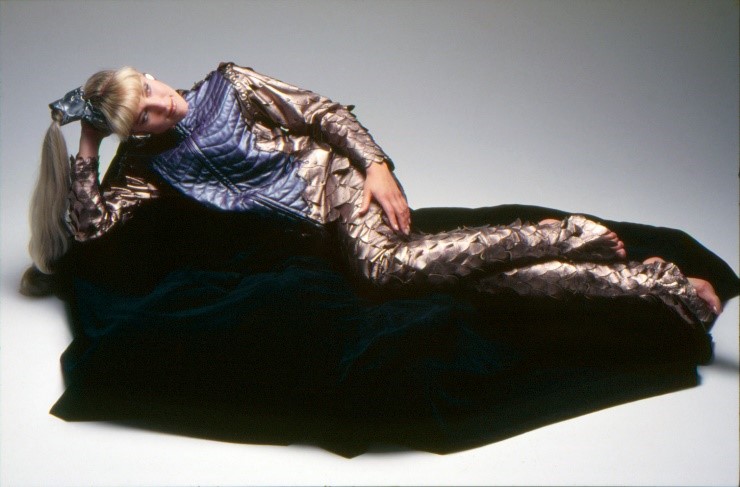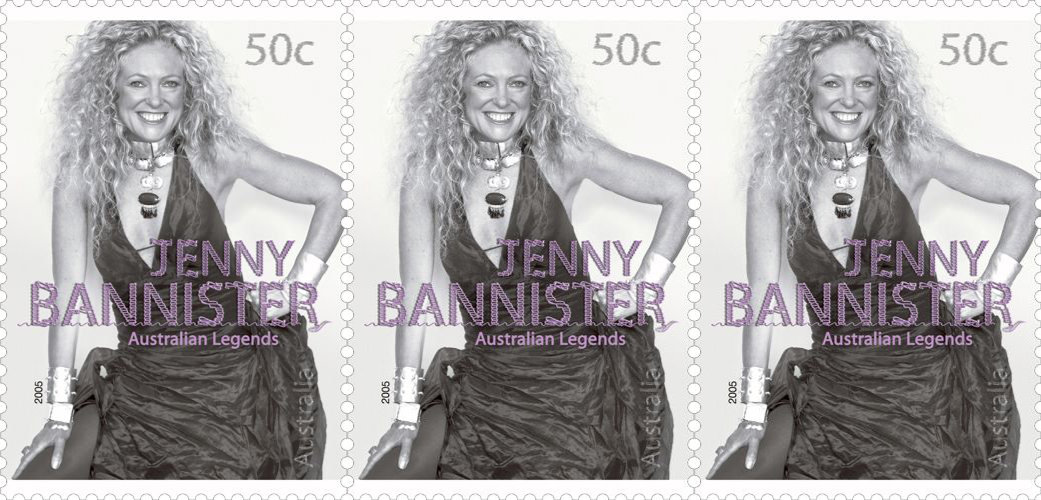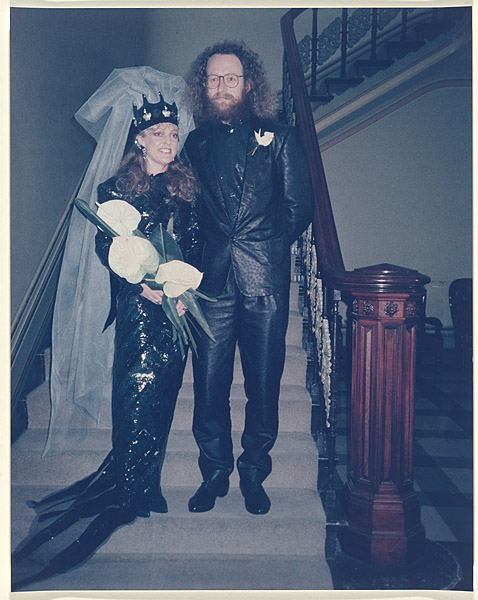JENNY BANNISTER
VS
FASHION
By Tenfingerz
Posted 1st May 2020

'Your clothes are an insult to the women of Melbourne. They’re cheap and they smell'
Jenny Bannister, Australian icon, pioneer of recycled fashion, staunch defender of ethical manufacturing practices, had that to say when she met the CEO of H&M at the opening of his first Australian store in 2014.
After more than 40 years in the fashion industry Jenny Bannister has no problem speaking her mind. She maintained a successful fashion business up until 2009. She’s made everything from punk wearable art to elegant couture. A showcase of Jenny’s more eccentric work is currently on display at RMIT Gallery in ‘Jenny Bannister Raids the Archives’.
The cutthroat nature of working in fashion means most people never speak openly about how they’ve been treated by the industry or dare to give brutal feedback to people in positions of power. With the kind of success Jenny has had, she can afford to tell it how it is.
Jenny lives between Byron Bay and Aireys Inlet with her surfer/economist husband Mongoose. In their Aireys Inlet abode, a spiral staircase sweeps you up through the circular two-level mud brick. Colourful and eclectic art fills the walls and Jenny’s collection of embellished straw hats greets you at the top of the stairs.
Jenny is seated at her dining room table which doubles as a workbench. She’s framed by floor to ceiling windows with views of the Southern Ocean. She’s flanked by mannequins wearing her current passion project - warrior shield maiden outfits, black mini dresses made with reclaimed neoprene and adorned with detritus. Breast plates made from the silver innards of yoghurt containers, pauldrons made of empty blister packs and collars of faux fur scraps salvaged from Melbourne luxury coat designer Gun Shy. “We’re going to smash the patriarchy with these.” Jenny’s wearable art pieces will fly to Brisbane with a local performance troupe to protest corporations supplying arms to Indonesia.
Jenny, now in her late 60s, weaves tales of her time in the fashion industry through a series of tangents and digressions. Stories range from bitter and angry, punctuated with a fist pounding the table to hilarious, as she throws her hands in the air, eyes wide, cackling at her own quips. Mongoose pipes in from time to time, “Stop embellishing!” as he potters by in the background. ”Oh c’mon! She’s not the tax department.” There is no stopping Jenny Bannister.
Jenny rose in popularity in the late 1970s. Her pieces were worn by Debbie Harry, Nick Cave, Tina Turner, Kylie Minogue and Naomi Campbell. Her fashion graced the pages of Vogue, Harper’s Bazaar and Elle. Her dresses are now in the collections of the NGV and Melbourne Museum. In 2005 Jenny’s contribution to Australian fashion was recognised by Australia Post through a commemorative stamp; alongside fashion icons Prue Acton, Collette Dinnigan, Akira Isogawa, Joe Saba and the late Carla Zampatti.

Zampatti began in fashion over a decade before Jenny. “I met her once and we talked about ridgebacks. Dogs. But you know, she was elegant. She made beautiful clothes, but she wasn't very experimental or anything.”
“When she came out from Italy. She had a little suitcase with a spare pair of panties in it and the equivalent of 20 cents Australian.”
Carla Zampatti was honoured at a state funeral on April 15th, which was attended by Alan Jones, Julie Bishop, John Howard and Tony Abbott. Carla was known for dressing politicians and prominent businesswomen.
Jenny also dressed elites but is perhaps at the opposite end of the Australian fashion spectrum. At one point in her career Jenny was stocked in luxury US department store Neiman Marcus selling to the kind of people who commute to the shops in a helicopter. However she started out creating pieces from upcycled denim, leather, and plastic. Jenny showcased these in underground fashion shows in dingy Melbourne bars. Her current exhibition shows a lo-fi video of models in her punk garments being carried down a catwalk by body builders.
When the stock market crashed in 1987 many of her contemporaries went bankrupt. Jenny went commercial, switching to darker colours and elegant evening wear. She continued to thrive in the industry with help from Mongoose. “My husband was an economist in the government. He used to do book-work for me. I wouldn’t be here without him”.
Opposite the downstairs bathroom hangs a framed photograph of Mongoose and Jenny at their wedding. Mongoose; in a black leather suit. Jenny wears a long green leather dress and medieval-style crown with a fountain of white tulle as the veil. “The most exotic leather I could think of on the planet. Patent python skin from Thailand.” Not the most ethical of materials; the late 1980s was a different time. The NGV acquired the dress as soon as they returned from their honeymoon.

In 2009, Jenny was forced into retirement. The Textile Clothing and Footwear Union prohibited her from continuing to employ subcontractors to make her garments in Australia. Regulations stipulated she needed to take on employees for at least 20 hours per week and pay them entitlements, a requirement she could not meet due to the seasonal nature of the fashion industry and a lack of funds. “The workplace ombudsman told me to go get everything manufactured in China.” Jenny did not want to do this, believing that it’s unfair to pay someone less in another country.
During her long career, Jenny has watched the rise of fast fashion and in turn the decline of manufacturing in Australia. A lot of the sustainable practices in the fashion industry she describes as “greenwashing”. A sentiment shared by many fashion activists.
H&M came under fire recently after launching their latest campaign. The brand announced all their clothing would be “made with recycled materials or sourced more sustainably by 2030”. Activists took to social media in response, pointing out the large amount of fashion waste the company currently creates. In 2018 that waste amounted to $4.3billion in unused stock.
Jenny now volunteers her time crafting for different charitable causes. Sewing reusable masks for a not-for-profit, making boomerang bags for local shops and joining the ‘Knitting Nanas’ in the Northern Rivers. “No one knows I’m a fashion person up there. They just think I’m some old woman.”
Today, Jenny wears a tight black dress with circular panels in desert earth tones. “This one has a good story.” It seems anything I point to has a good story with a tangent or two or three. The dress is made of organic cotton yoga pant off-cuts and inspired by Kata Tjuta, west of Uluru. She has another version of the dress downstairs in blue and green, inspired by aerial views of billabongs along the Murray River where she grew up.
Jenny has also been experimenting with eco-dyeing, using organic materials to create pigments for dyeing and printing on clothes. She’d love to get back into business, but the stress of the industry prevents her. “Every time I go to, the red tape of running a business again just gives me a headache. I just drink a bottle of wine and lie down.”
‘Jenny Bannister Raids the Archives’ is on at RMIT Gallery until May 8.

By Tenfingerz
Creative director of Fast Fashun. After leaving a career in styling and fashion photography, Tenfingerz has been creating interactive educational fashion events for the past decade. Now embarking on a covid related career pivot, releasing this online magazine while studying professional writing at RMIT.
tenfingerz.com

